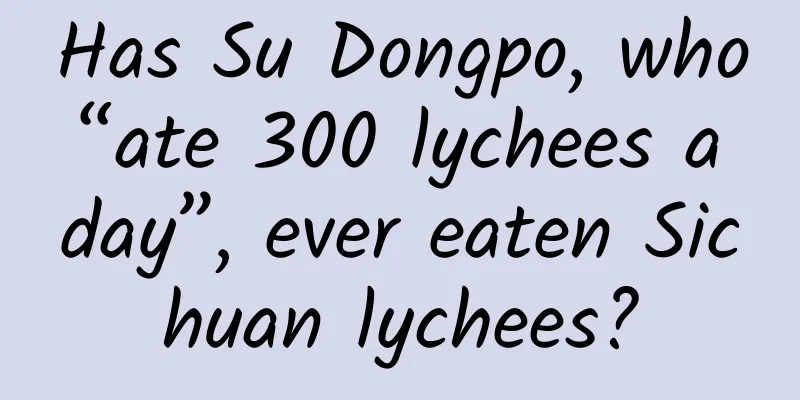Has Su Dongpo, who “ate 300 lychees a day”, ever eaten Sichuan lychees?

|
As we all know, the great writer Su Dongpo was a foodie, and he especially loved lychees, a southern fruit. He left behind the popular poem "A Unique Item in Huizhou: Eating Lychees": "I can eat 300 lychees a day, and I am willing to be a Lingnan person forever" (Figure 1). As a loyal lychee fan, he was willing to be a Lingnan (Guangdong) person forever just to taste delicious lychees every day. It is midsummer now, and the late-ripening lychees from Sichuan are beginning to be put on the market. While reading this poem, a question suddenly flashed in my mind: Su Shi is a native Sichuanese, has he ever tasted Sichuan lychees? Figure 1. Su Shi (left), a great writer of the Song Dynasty who was born in Meishan, Sichuan, and the queen of southern fruits - lychee (right) Image source: Internet To answer this question, we must first clarify a prerequisite: Did Sichuan produce lychees during the Song Dynasty when Su Shi lived? Among the main lychee producing areas in China today, if ranked by production, Guangdong, Guangxi and Hainan are far ahead. Sichuan, although not as good as the top three, is unique because it produces the latest ripening lychees. What is even more amazing is that more than 90% of Sichuan's lychee production is concentrated in one county in southern Sichuan, namely Hejiang County, Luzhou City (Figure 2). Figure 2. Location of Hejiang County in the maps of Sichuan and Chongqing Image source: Drawn by Ye Lin However, if we go back to the Song Dynasty, the ranking of the top three lychee producers in China was different. Cai Xiang, a Song Dynasty scholar, once said: "As for lychees, only Fujian, Guangdong, and Bashu have them." It can be seen that the top three at that time were Fujian, Guangdong, and Sichuan. The planting area of Sichuan lychees is much larger than it is today. According to historical records, during the Tang and Song Dynasties, lychees were produced in Chengdu, Meishan, Leshan, Yibin, Luzhou, and even Fuling and Wanzhou in Chongqing. Among them, lychees from Luzhou and Yibin (also known as Rongzhou in ancient times) are the most famous. Lu You of the Song Dynasty wrote in a poem: "I will always remember the green lychees in Rongzhou", and Zixi of the Tang Dynasty wrote in a poem: "Passenger boats at Yugan Ferry, people living under the lychee forest" to describe the grand growth of lychees in Yibin and Luzhou (Figure 3). Figure 3. Geographical distribution and tribute routes of lychees in the Tang and Song dynasties Image source: Reference 2 It seems that the objective conditions for eating lychees in Sichuan were met at that time. The next step is to find direct evidence. So, the author searched the surviving historical materials for Su Shi’s writings to find records of eating lychees. As a result, it was found that there are 20 poems about lychees that have been passed down by Su Shi. These poems were not written in Sichuan, but mostly in Lingnan (Guangdong), and the content did not mention eating Sichuan lychees (Figure 4). This is strange. Since Su Shi loved lychees so much and lychees were produced in abundance in Sichuan at that time, why was there no mention of them in Su Shi's poems that have been passed down to the world? Figure 4. Su Shi’s poem about litchi Image source: Reference 3 In order to answer this question, the author further entered into Su Shi's world and explored his life trajectory in Sichuan... Su Shi was born in Meishan, Sichuan in 1036. It was not until March 1056 that the 20-year-old Su Shi left Sichuan for the first time and went to Beijing with his father and brothers to take the imperial examination. In 1057, Su Shi returned home from the capital Bianliang (now Kaifeng City, Henan Province) to attend his mother's funeral. During these two trips to and from Sichuan, he took the route from Meishan to the north, passing through Jianmen Pass and Guangyuan. Guangyuan is at a high latitude, and although there are records of sporadic lychee planting, the yield and quality are not outstanding. Moreover, Su Shi left Sichuan at the beginning of the year, and lychees were not yet ripe. He returned to Sichuan to attend his mother's funeral, so he had no intention of enjoying the scenery during the journey, and it was unlikely that he ate lychees. In October 1059, after the mourning period was over, Su Shi set out from Meishan and sailed south along the Minjiang River, passing through Leshan, entering the Yangtze River after arriving in Yibin, and then along Luzhou, Chongqing, passing Fuling, Wanzhou, and arriving in Jingzhou at the end of the year, and then heading north to Bianliang. In 1066, Su Shi returned home to mourn for his father's death. In 1069, after the mourning period was over, he left Sichuan and returned to Beijing again. Both times he took the Minjiang and Yangtze River route. Leshan, Yibin, Luzhou, Chongqing Fuling, and Wanzhou on this route were the main lychee production areas in Sichuan and Chongqing during the Song Dynasty. Su Shi was almost traveling along a lychee route (Figure 5). However, Su Shi still did not leave any record of eating lychees during these three journeys. Why? Figure 5. Cities that Su Shi passed through when he entered and left Sichuan. Image source: Drawn by Ye Lin According to historical records, Su Shi's first trip out of Sichuan along the Minjiang and Yangtze River route began in October 1059. At the end of the year, he had arrived in Jingzhou, Hubei, and missed the summer lychee ripening period. In June 1066, Su Shi and his brothers set out from Bianjing with their father's coffin, went down to Jingzhou, and returned to Meishan along the Minjiang and Yangtze River route. Although it was summer at this time, Su Shi was eager to go home for the funeral and should not have been nostalgic for the food along the way. When he returned to Bianliang for the last time after his mourning period was over, it was already February 1069, which was obviously not the season for lychees to ripen. Therefore, the author speculates that Su Shi most likely missed the opportunity to taste Sichuan lychees during these journeys. Did Su Shi eat lychees in his hometown of Meishan since he was a child? Although I did not find direct evidence for this question, I found an important clue from a poem. In 1090, the 53-year-old Su Shi wrote "A Letter to Cai Zihua" in Hangzhou: "When my old friend sent me to the east, he planted lychees for me to return. The lychees have turned red and my hair has turned white, but I am still a guest in the south of the Yangtze River who has not returned." In the poem, he recalled that 20 years ago, when he was mourning for his father, he and his friends planted lychee trees at home, and agreed to wait until the lychees turned red, and then he would go home to taste them with his friends. From this poem, it can be inferred that Meishan can produce lychees, and the young Su Shi may have eaten lychees in his hometown (Figure 6). However, Su Shi never returned to his hometown after that. He left every plant and tree in his hometown waiting for the return of the wanderer, and watched for a thousand years... Figure 6. Ancient lychee trees on display in the San Su Temple. Image source: Internet After the Song Dynasty, due to climate and environmental changes, human destruction and other reasons, the main lychee production area in Sichuan gradually shrank, and now only exists in a corner of Hejiang County, Luzhou, and the ancient lychees in Meishan also disappeared in the long river of history. In 2007, in order to fulfill Su Shi's thousand-year-old wish, the staff of Su Shi's former residence, the Three Su Temple, introduced lychee trees from Hejiang, Luzhou. After more than 10 years of careful care, this lychee tree miraculously survived, gradually flourishing and bearing fruit. From July 8 to 9, 2022, the Three Su Temple launched the "Eat 300 Lychees a Day" event, providing lychees from the Three Su Temple, Hejiang, Sichuan, and Huizhou, Guangdong to tourists who came here to visit. Each person was limited to 300 lychees. Everyone sat or stood under the lychee trees, enjoying the delicious lychees. It was very pleasant, and even the little squirrels on the trees came to join in the fun (Figure 7). If the hospitable Su Shi saw such a beautiful and warm scene, he would also smile. Figure 7. “Eat 300 lychees a day” activity at the Three Su Temple. Image source: Internet References: 2. Zhang Sheng. Geographical distribution of litchi in ancient China and changes in its tribute areas[J]. Journal of Chinese Historical Geography, 2019, 34(01):98-107. 3. Yang Jiajia, Li Lingli. Research on Su Shi’s Lychee Poems[J]. Journal of Huizhou University, 2023, 43(02): 29-35. DOI:10.16778/j.cnki.1671-5934.2023.02.005. 4. Nie Shunxin. Climate, commercialization and planting technology: a study on the expansion of litchi planting in the Song Dynasty[J]. Chinese Agricultural History, 2014, 33(04): 22-29. 5. Lan Yong. Historical research on the distribution of litchi cultivation in southwest China[J]. Chinese Agricultural History, 1988(03):68-76. 6. Kong Fanli. Chronicle of Su Shi. Published by Zhonghua Book Company, 2005. 7. You Xin and He Guangbing. Lychees at the “Three Su Temple” in Meishan are ripe. Web link: https://www.sohu.com/a/156285344_828424. |
<<: Can't help but step on the "empty pedal"? No kidding! Shaking your legs is really a good habit!
>>: This life that had been sleeping for 100 million years was awakened by a man-made accident.
Recommend
Why don't electric cars use nuclear batteries?
So far, the greatest energy that humans can maste...
In-depth analysis of Android's custom layout
[[124174]] Words written in front: This article w...
Attention! There are only seven days left for iOS 15.4.1. Will you choose to upgrade?
Regarding the iOS 15.0 - 15.1.1 Cheyote jailbreak...
Review of Pinduoduo’s gameplay in 2019: branding and hit products!
Today I will mainly share with you some trial and...
Case analysis: How to build a community content system and active users?
This sharing session will mainly focus on strateg...
Foreign server rental price list, overseas server rental
Foreign server rental price list, overseas server...
Android: Imitate WeChat source code
Source code introduction: Test account: 123456888...
Wi-Fi 6 router purchasing guide: If you don’t have demand, you can really wait for products in the thousand-yuan range
Although the Wi-Fi Alliance launched the Wi-Fi 6 ...
Are sleep twitches divided into those that wake yourself up and those that wake others up?
Image source: Tuchong Creative I was sleeping sou...
Recommended by experts: Must-read books for iOS development
Some iOS development books I recommend Last time ...
When Ai Fejieni, one of the top three contestants of "The Rap of China", encountered Baidu's campus recruitment, what kind of opportunity was this?
On the evening of September 9, the final of "...
How to plan an online promotion program? What are the online promotion channels?
As the Internet becomes more and more developed, ...
How does the Android market distribute and promote apps?
This article uses some optimization operations pe...









